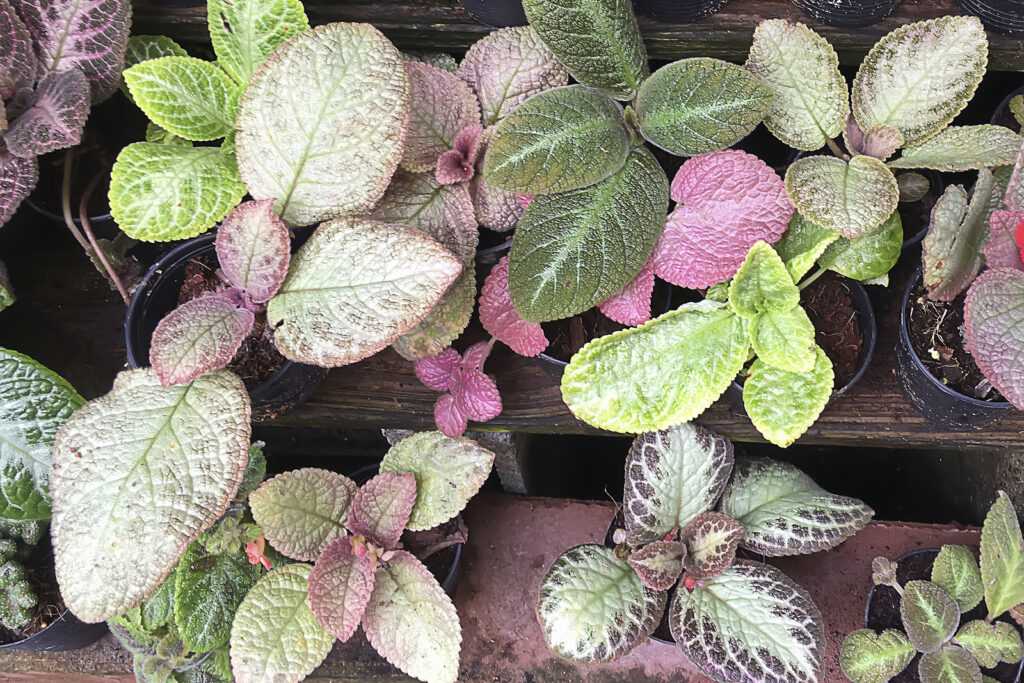Episcia–commonly called flame violet or carpet plant–is a small evergreen tropical perennial with long slender stems that produce small plantlets at their ends. The leaves are oval and hairy. The flowers are tubular to bell-shaped, flame red or metallic pink, and appear in spring and summer. Episcia stands about 6 inches (15cm) tall.
Episcia are grown for their soft, colorful foliage and salvaform flowers. In tropical regions, Episcia is grown as a ground cover. In temperate, cool-winter regions Episcia is grown indoors in hanging baskets or in terrariums.
Episcia is a genus of 6 species of creeping, mat-forming plants. Episcia spreads via stolons that root as they creep along. Episcia is native to tropical forests and rocky habitats in Mexico and South America.
Get to know Episcia
- Plant type: Evergreen perennial
- Growing zones and range: Zones 14-15
- Hardiness: Tender
- Height and width: 4 to 6 inches (10-15cm) tall, indefinite width
- Foliage: Soft, colorful leaves
- Flowers: 5-lobed flowers borne singly or in small racemes
- Bloom time: Spring to autumn
- Uses: Groundcover, hanging basket, terrarium plant
- Common name: Flame violet, carpet plant
- Botanical name: Episcia
- Family name: Gesneriaceae
- Origin: Rocky habitats from Mexico to South America

Where to plant Episcia
- Light outdoors: Grow Episcia outdoors in partial shade.
- Light indoors: Grow Episcia in bright filtered light.
- Soil outdoors: Plant Episcia in fertile, humus-rich, moist but sharply drained soil.
- Soil indoors: Grow Episcia in soilless potting mix with added perlite or vermiculite.
When to plant Episcia
- Set container-grown Episcia outdoors any time of the year in tropical regions.
Planting and spacing Episcia
- Episcia spreads via stolons that root as they creep along. Set plants at least 12 inches (30cm) apart.
How to water and feed Episcia
- During the growing season, water Episcia moderately. Keep Episcia just moist in winter.
- Fertilize Episcia with quater-strength, balanced fertilizer at each watering during the growing season.
Episcia care
- Episcia creeps and roots with stolons. Plants can become invasive if they are ignored.
Growing Episcia as a houseplant
- Grow Episcia in a warm, humid room where light is bright.
- The growing medium should be extra rich and evenly moist.
- Do not allow cold water to touch the leaves or they may spot.
- Fertilise monthly during spring and summer.
- After the plant flowers, cut it back to encourage new growth and pinch the new growth to encourage fullness.
Episcia pests and diseases
- Episcia can be attacked by spider mites, whiteflies, mealybugs, and botrytis blight.

Episcia propagation
- New plants can be propagated by rooting the plantlets that form at the ends of the stems or from stem cuttings.
Episcia varieties to grow
- Episcia cupreata, flame violet. Wrinkled leaves that are green, reddish green, copper or market with silver; flowers are dark red with yellow undersides and red spots. Cultivars include ‘Chocolate Velour’ has heavily textured dark brown to black leaves; ‘Metallica’ has metallic pink margins and bands of pale green in the center; ‘Variegata’ has silver pattern onc hte center.
- E. dianthiflora, lace flower vine. Soft hairy green leaves that are red veined; white flowers.
- E. lilacina. Quilted leaves that are green, reddish-green, or bronze often with rosepurple undersides; flowers are lavender with yellow throats.
- E. reptans, flame violet. Dark green leaes with pale green or siler midribs; flowers are dark red, pink inside the tube and fringed.















